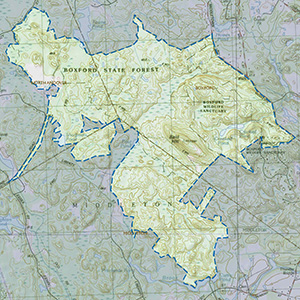Important Bird Area: Bald Hill Reservation
Site Summary
Nominated By
Jim Berry
Size
1,921 acres
Towns and Counties
Boxford, Middleton, North Andover; Essex County
Ownership
69% Dept. of Conservation and Recreation, Mass Division of Fisheries and Wildlife, 26% Eastern Essex County Greenbelt Association, 5% municipal
Major Habitats
80% oak-conifer transitional forest, 5-10% palustrine wooded swamp, 5-7% northern hardwood forest
Land Use
nature & wildlife, conservation/land trust, other recreation, forestry, undeveloped
Serious Threats
introduced animals/feral pets, cowbird parasitism, residential/commercial development, disturbance to birds or habitat
Minor Threats
predators, soil erosion/ degradation, hydrologic changes
IBA Criteria
- Category 2: Sites containing assemblages of species characteristic of a representative, rare, threatened, or unique habitat within the state or region.
- Category 4: Land Birds: The site is an important migratory stopover or seasonal concentration site for migratory land birds (e.g., warblers). Sites may also qualify on the basis of supporting exceptionally high densities of breeding species as shown from point counts or other surveys or if they represent "migrant traps" relative to surrounding areas. Strong consideration will be given to areas with consistently high overall species diversity..
Site Description
Bald Hill Reservation is an amalgamation of contiguous forest land consisting of Boxford State Forest (927 acres,); the Boxford Wildlife Sanctuary, owned by MDFW (390 acres); and a mosaic of lots interspersed among and contiguous to the state lands, owned by the Essex County Greenbelt Association (456 acres), the New England Forestry Foundation (40 acres), the town of Middleton (93 acres), and Essex County (15 acres). It consists almost entirely of mixed forest, the usual mixture of upland and swamp, and includes Crooked Pond, recently dammed by beavers. The geologic feature is Bald Hill (267 feet), where a small clearing at the top is mowed annually by the Department of Conservation and Recreation even though the view of surrounding land is now obscured by tall trees. On the north side of Bald Hill is one of the few stands of true northern hardwood forest in Essex County, about 100 acres' worth. Management is cooperative between the two state agencies (Department of Conservation and Recreation and Department of Fish and Game) and Greenbelt. There is an excellent network of trails, which are posted to exclude motorized vehicles.
Current Conservation Status
Enforcement of the prohibited motorized vehicles is, as in many places, difficult to enforce, and dirt bikers damage the trails and disturb the wildlife. Cowbirds are a serious threat to the nesting songbirds, and penetrate deep within the forest, not just around the edges. This probably means that the trail network, which consists largely of old logging roads, is having a fragmenting effect on the otherwise solid forest, which the cowbirds appear to be using to their advantage. The threat from recent beaver damming is unknown, but has reduced the flow of the outlet stream probably to the detriment of nesting Louisiana Waterthrushes, which are less in evidence now in that part of the forest. Otherwise, the higher water level of Crooked Pond does not seem to be a problem, and is increasing the amount of shrubby swampland along the inlet stream, possibly to the benefit of species such as Canada Warblers, Northern Waterthrushes, and Blue-gray Gnatcatchers.
Ornithological Significance
Bald Hill Reservation has Eastern Hemlock and some ledge habitat, one of the county's few stands of northern hardwood forest, and even a significant remnant of Atlantic White Cedar swamp. The site is consequently used as nesting habitat by several northern species that are not normally found breeding this far south or east in New England. A few of these species breed almost nowhere else in Essex County, such as the Northern Goshawk, which has nested in the northern hardwood tract since at least 1934. Crooked Pond, as birders know this area, is so rich in breeding-season bird life that it is the single biggest interior birding hotspot in the county. The diversity of habitats, in particular the northern hardwood and Atlantic White Cedar stands, and the remarkable mix of breeding birds this forest supports, make Bald Hill a rare and unique habitat for northeastern Massachusetts. In this sense it qualifies in category 4 as well as 2 and 3f. In addition, this is the only place in Essex County where a singing male Cerulean Warbler has been found in multiple years (1980s-1990s), though proof of nesting has yet to be obtained. A pair of Northern Goshawk nests annually in the northern hardwoods, one of only a handful of nest locations on the North Shore.
The estimated numbers of breeding pairs below are based on Jim Berry's experience birding this forest over the last 30 years, and discussions with others who have also birded it extensively. Estimates are based on relative abundances. There are no documented counts of breeding birds. Nests of most of the species listed have been found.
Other Flora or Fauna of Significance
The following dragonflies have been found on the property: Ringed Boghaunter and Arrowhead Spiketail (C. Leahy).
Data Sources
J. Berry, personal observation.




